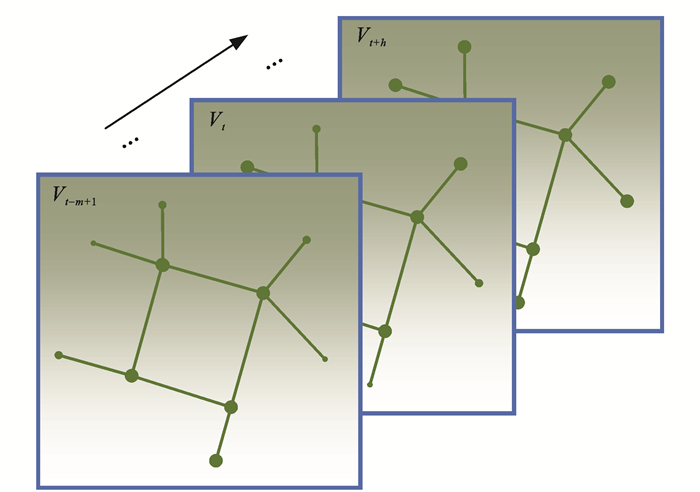Prediction of traffic swarm movement situation based on generalized spatio-temporal graph convolution network
-
摘要: 针对当前高速公路与城市快速路交通拥堵现象愈发严重,为交通管理与控制造成巨大困难的问题,提出了一种基于广义时空图卷积网络(GSTGCN)的交通速度预测模型;基于交通数据自身具有的复杂时空特性,定义了广义交通数据图结构,同时构建了广义图的邻接关系;基于图卷积网络基础理论,采用切比雪夫近似与一阶近似简化了图卷积操作的计算成本,建立了广义图卷积算子;结合广义图卷积模块、标准卷积模块与线性全连接层,提出了用于提取复杂交通数据时间、空间特征的GSTGCN模型;利用美国威斯康星州密尔沃基市快速路网上架设的38个检测器,在21个工作日以每5 min为单位记录了车辆速度、流量和占有率数据,测试了GSTGCN模型在该数据集上的短期交通速度预测精度与训练效率。分析结果表明:相较于传统自回归求和滑动平均(ARIMA)模型、长短时记忆(LSTM)模型以及近期的STGCN模型,GSTGCN模型在交通速度的均方根误差、平均绝对误差和平均绝对百分比误差指标上分别降低了22.79%、22.97%和16.73%;此外,GSTGCN模型的训练时长比STGCN模型和LSTM模型分别降低了5.17%和75.71%。可见,GSTGCN模型能够有效处理复杂交通时空数据结构,准确预测交通速度,并为交通管控提供交通群体的运动态势信息。Abstract: To address the problem that traffic congestion on highways and urban expressways is becoming more and more serious and causes great difficulties for traffic management and control, a traffic speed prediction model was proposed based on the generalized spatio-temporal graph convolution network (GSTGCN). According to the complex spatio-temporal characteristics of traffic data, the generalized traffic data graph structure was defined, and the adjacency relationships of the generalized graph were constructed. By the basic theory of graph convolution network, the Chebyshev approximation and the first-order approximation were adopted to simplify the computational cost of the graph convolution operation, and a generalized graph convolution operator was established. With the generalized graph convolution module, standard convolution module, and linear fully-connected layer, a GSTGCN model was presented to extract the spatial and temporal characteristics of complex traffic data. The vehicle speed, flow, and occupancy datum were recorded by 38 detectors at 5-minute intervals for 21 weekdays on the expressway network in Milwaukee, Wisconsin, USA. The short-term traffic speed prediction accuracy and training efficiency of the GSTGCN model were evaluated on this data set. Analysis results show that compared with the results of the traditional auto regressive integrated moving average (ARIMA) model, the long short-term memory (LSTM) model, and the recent spatio-temporal graph convolution network (STGCN) model, the root mean square error, mean absolute error, and mean absolute percentage error of the GSTGCN model in the traffic speed prediction reduces by 22.79%, 22.97%, and 16.73%, respectively. Moreover, the training time of the GSTGCN model is 5.17% and 75.71% shorter than those of the STGCN model and LSTM model, respectively. Therefore, the GSTGCN model is able to effectively deal with the complex spatio-temporal traffic data structure, accurately predict the traffic speed, and provide information on the movement situation of traffic swarm for the traffic control and management. 4 tabs, 6 figs, 31 refs.
-
表 1 数值分布
Table 1. Numerical distributions
数值分布 在数据中的占比/% (μ-σ, μ+σ) 68.27 (μ-2σ, μ+2σ) 95.45 (μ-3σ, μ+3σ) 99.73 表 2 不同预测模型的性能比较
Table 2. Performance comparison of different prediction models
模型 RMSE MAE MAPE/% ARIMA 7.77 8.46 10.43 SAE 7.47 8.32 8.22 LSTM 8.31 7.81 7.87 STGCN 6.89 5.79 7.17 GSTGCN 5.32 4.46 5.97 表 3 部分时段真实数据与模型预测值对比
Table 3. Comparison between real data and model prediction results for part of period
(mile·h-1) 时间 09:05 09:10 09:15 09:20 09:25 09:30 09:35 09:40 09:45 09:50 09:55 真实数据 59.17 58.17 55.83 56.53 53.80 57.61 56.80 54.07 55.12 57.73 58.89 LSTM 60.39 58.71 58.01 59.05 57.08 54.73 58.19 56.98 54.77 56.17 56.75 STGCN 59.17 58.48 56.41 56.39 58.25 57.93 57.69 57.71 57.53 57.25 58.10 GSTGCN 59.37 58.36 55.19 56.69 52.90 57.14 57.09 54.07 54.68 57.88 59.25 表 4 GSTGCN模型与GSTGCN-Simple模型的性能比较
Table 4. Performance comparison of GSTGCN and GSTGCN-Simple models
模型 RMSE MAE MAPE/% GSTGCN-Simple 5.43 4.71 6.38 GSTGCN 5.32 4.46 5.97 1. Numerical distribution

2. Performance comparison of different prediction models

3. Comparison of prediction results between real data and models for part of period (mile·h−1)

4. Performance comparison of GSTGCN and GSTGCNSimple models

-
[1] 刘静, 关伟. 交通流预测方法综述[J]. 公路交通科技, 2004, 21(3): 82-85. doi: 10.3969/j.issn.1002-0268.2004.03.022LIU Jing, GUAN Wei. A summary of traffic flow forecasting methods[J]. Journal of Highway and Transportation Research and Development, 2004, 21(3): 82-85. (in Chinese) doi: 10.3969/j.issn.1002-0268.2004.03.022 [2] VAN DER VOORT M, DOUGHERTY M, WATSON S. Combining kohonen maps with ARIMA time series models to forecast traffic flow[J]. Transportation Research Part C: Emerging Technologies, 1996, 4(5): 307-318. doi: 10.1016/S0968-090X(97)82903-8 [3] XIE Yuan-chang, ZHANG Yun-long, YE Zhi-rui. Short-term traffic volume forecasting using Kalman filter with discrete wavelet decomposition[J]. Computer-Aided Civil and Infrastructure Engineering, 2007, 22(5): 326-334. doi: 10.1111/j.1467-8667.2007.00489.x [4] WILLIAMS B M. Multivariate vehicular traffic flow prediction: evaluation of ARIMAX modeling[J]. Transportation Research Record, 2001(1776): 194-200. [5] WU Ren-fei, ZHENG Xun-jia, XU Yong-neng, et al. Modified driving safety field based on trajectory prediction model for pedestrian-vehicle collision[J]. Sustainability, 2019, 11(22): 6254. doi: 10.3390/su11226254 [6] CHENG Shi-fen, LU Feng, PENG Peng, et al. Short-term traffic forecasting: an adaptive ST-KNN model that considers spatial heterogeneity[J]. Computers, Environment and Urban Systems, 2018, 71: 186-198. doi: 10.1016/j.compenvurbsys.2018.05.009 [7] HONG W C. Traffic flow forecasting by seasonal SVR with chaotic simulated annealing algorithm[J]. Neurocomputing, 2011, 74(12/13): 2096-2107. [8] YIN Hong-bin, WONG S C, XU Jian-min, et al. Urban traffic flow prediction using a fuzzy-neural approach[J]. Transportation Research Part C: Emerging Technologies, 2002, 10(2): 85-98. doi: 10.1016/S0968-090X(01)00004-3 [9] 窦慧丽, 刘好德, 吴志周, 等. 基于小波分析和ARIMA模型的交通流预测方法[J]. 同济大学学报(自然科学版), 2009, 37(4): 486-489, 494. https://www.cnki.com.cn/Article/CJFDTOTAL-TJDZ200904016.htmDOU Hui-li, LIU Hao-de, WU Zhi-zhou, et al. Study of traffic flow prediction based on wavelet analysis and autoregressive integrated moving average model[J]. Journal of Tongji University (Natural Science), 2009, 37(4): 486-489, 494. (in Chinese) https://www.cnki.com.cn/Article/CJFDTOTAL-TJDZ200904016.htm [10] JIA Yu-han, WU Jian-ping, DU Yi-man. Traffic speed prediction using deep learning method[C]//IEEE. 2016 IEEE 19th International Conference on Intelligent Transportation Systems (ITSC). New York: IEEE, 2016: 1217-1222. [11] LYU Yi-sheng, DUAN Yan-jie, KANG Wen-wen, et al. Traffic flow prediction with big data: a deep learning approach[J]. IEEE Transactions on Intelligent Transportation Systems, 2015, 16(2): 865-873. [12] MAO Pei-pei, JI Xin-kai, QU Xu, et al. Deep learning based vehicle position estimation for human drive vehicle at connected freeway[C]//IEEE. 2020 IEEE 23rd International Conference on Intelligent Transportation Systems (ITSC). New York: IEEE, 2020: 1-6. [13] MA Xiao-lei, TAO Zhi-min, WANG Yin-hai, et al. Long short-term memory neural network for traffic speed prediction using remote microwave sensor data[J]. Transportation Research Part C: Emerging Technologies, 2015, 54: 187-197. doi: 10.1016/j.trc.2015.03.014 [14] GAO Hong-bo, SU Hang, CAI Ying-feng, et al. Trajectory prediction of cyclist based on dynamic Bayesian network and long short-term memory model at unsignalized intersections[J]. Science China Information Sciences, 2021, 64(7): 1-13. [15] FU Rui, ZHANG Zuo, LI Li. Using LSTM and GRU neural network methods for traffic flow prediction[C]//IEEE. 2016 31st Youth Academic Annual Conference of Chinese Association of Automation (YAC). New York: IEEE, 2016: 324-328. [16] CUI Zhi-you, KE Rui-min, PU Zi-yuan, et al. Deep bidirectional and unidirectional LSTM recurrent neural network for network-wide traffic speed prediction[EB/OL]. (2019-11-23)[2021-12-10]. https://arxiv.org/abs/1801.02143. [17] YANG Bai-lin, SUN Shu-lin, LI Jian-yuan, et al. Traffic flow prediction using LSTM with feature enhancement[J]. Neurocomputing, 2019, 332: 320-327. doi: 10.1016/j.neucom.2018.12.016 [18] WU Yuan-kai, TAN Hua-chun, QIN Ling-qiao, et al. A hybrid deep learning based traffic flow prediction method and its understanding[J]. Transportation Research Part C: Emerging Technologies, 2018, 90: 166-180. doi: 10.1016/j.trc.2018.03.001 [19] YU Hai-yang, WU Zhi-hai, WANG Shu-qin, et al. Spatiotemporal recurrent convolutional networks for traffic prediction in transportation networks[J]. Sensors, 2017, 17(7): 1501. doi: 10.3390/s17071501 [20] JIN Wen-wei, LIN You-fang, WU Zhi-hao, et al. Spatio-temporal recurrent convolutional networks for citywide short-term crowd flows prediction[C]//ICCDA. Proceedings of the 2nd International Conference on Compute and Data Analysis. New York: ICCDA, 2018: 28-35. [21] YU Bing, YIN Hao-teng, ZHU Zhan-xing. Spatio-temporal graph convolutional networks: a deep learning framework for traffic forecasting[C]//IJCAI. Proceedings of the Twenty-Seventh International Joint Conference on Artificial Intelligence. Stockholm: IJCAI, 2017: 3634-3640. [22] 王增光, 王海起, 陈海波. 基于图卷积网络的短时交通速度预测[J]. 计算机与现代化, 2021(9): 99-105. https://www.cnki.com.cn/Article/CJFDTOTAL-JYXH202109015.htmWANG Zeng-guang, WANG Hai-qi, CHEN Hai-bo. Short-term traffic speed prediction based on graph convolutional network[J]. Computer and Modernization, 2021(9): 99-105. (in Chinese) https://www.cnki.com.cn/Article/CJFDTOTAL-JYXH202109015.htm [23] ZHAO Ling, SONG Yu-jiao, ZHANG Chao, et al. T-GCN: a temporal graph convolutional network for traffic prediction[J]. IEEE Transactions on Intelligent Transportation Systems, 2019, 21(9): 3848-3858. [24] YAN Si-jie, XIONG Yuan-jun, LIN Da-hua. Spatial temporal graph convolutional networks for skeleton-based action recognition[C]//AAAI. Proceedings of the AAAI Thirty-second AAAI Conference on Artificial Intelligence. New Orleans: AAAI, 2018: 12328. [25] 张懿扬, 陈志, 岳文静, 等. 基于时空图卷积网络的视频中人物姿态分类[J]. 计算机技术与发展, 2021, 31(10): 70-75. https://www.cnki.com.cn/Article/CJFDTOTAL-WJFZ202110012.htmZHANG Yi-yang, CHEN Zhi, YUE Wen-jing, et al. Human pose classification in video based on spatial temporal graph convolutional networks[J]. Computer Technology and Development, 2021, 31(10): 70-75. (in Chinese) https://www.cnki.com.cn/Article/CJFDTOTAL-WJFZ202110012.htm [26] 张蔚澜, 齐华, 李胜. 时空图卷积网络在人体异常行为识别中的应用[J/OL]. 计算机工程与应用, (2021-11-03)[2021-12-10]. http://kns.cnki.net/kcms/detail/11.2127.tp.20211103.1055.002.html.ZHANG Wei-lan, QI Hua, LI Sheng. Application of spatial temporal graph convoutional networks in human abnormal behavior recognition[J/OL]. Computer Engineering and Applications, (2021-11-03)[2021-12-10]. http://kns.cnki.net/kcms/detail/11.2127.tp.20211103.1055.002.html. (in Chinese) [27] YE Jie-xia, ZHAO Juan-juan, YE Ke-jiang, et al. How to build a graph-based deep learning architecture in traffic domain: a survey[J]. IEEE Transactions on Intelligent Transportation Systems, 2020, 23(5): 3904-3924. [28] BRUNA J, ZAREMBA W, SZLAM A, et al. Spectral networks and locally connected networks on graphs[EB/OL]. (2014-05-21)[2021-12-10]. https://doi.org/10.48550/arXiv.1312.6203. [29] KIPF T N, WELLING M. Semi-supervised classification with graph convolutional networks[C]//ICLR. Proceedings of the 5th International Conference on Learning Representations. Toulon: ICLR, 2017: 1-14. [30] DEFFERRARD M, BRESSON X, VANDERGHEYNST P. Convolutional neural networks on graphs with fast localized spectral filtering[C]//ACM. Proceedings of the 30th International Conference on Neural Information Processing Systems. New York: ACM, 2016: 3844-3852. [31] Wisconsin Traffic Operations and Safety Laboratory. The WisTransportal data hub information system[EB/OL]. (2016-12-18)[2021-12-10]. http://transportal.cee.wisc.edu/. -





 下载:
下载:













